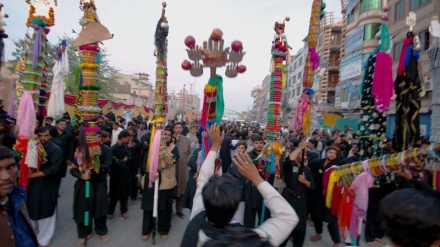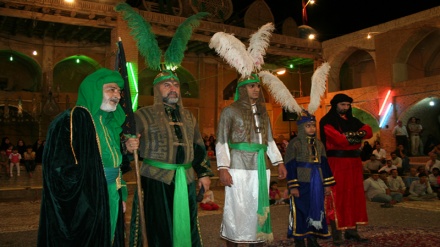Muharram mourning traditions in different lands - 35
Welcome to the 35th part of the series titled “Muharram Mourning Traditions in Different Lands” that we started broadcasting as of October 15 on a daily basis, to commemorate the heartrending tragedy of Karbala, and the martyrdom of Imam Husain (AS), the grandson of Prophet Mohammad (SAWA).
In this series, which delves into the mourning traditions associated with the Immortal Epic of Ashura, we have been focusing on the various norms prevalent in different towns and cities of Iran for commemorating the heartrending tragedy of Karbala, after having dwelt on the history of mourning in different countries of the world for Imam Husain (AS).
Today also we continue our yesterday’s discussion of “Shaam-e- Gharibaan” which is Persian for the tragic evening that befell the bereaved ladies and orphaned children of the household of the Prophet’s family on Ashura of 10th Muharram, following heartrending martyrdom from morning till afternoon, of the Imam, his sons, brothers, nephews, and companions. Shaam is Persian for evening, while Gharibaan means travelers, and it refers to the fact that the Prophet’s Ahl al-Bayt were in a foreign land as travelers far away from their hometown Medina, when the bloodcurdling tragedy of Karbala and its equally heart-wrenching aftermath, befell them. On that evening, the brutal Omayyad soldiers burnt down the tents or encampment of the Imam, thereby increasing the grief and plight of the horrified survivors. Thus, “Shaam-e- Gharibaan” is a reminder of the deep sadness, enormous loss, and profound grief of the members of the Imam’s family following his martyrdom. Yesterday we presented you glimpses of “Shaam-e Gharibaan” ceremony in Qom, and today we will take you to Mashhad for commemoration of this ceremony. Stay with us.
Mashhad in Khorasan in northeastern Iran, which means place of martyrdom, is the city that grew around the blessed shrine of the Prophet’s 8th Infallible Heir, Imam Reza (AS). It draws millions of pilgrims and visitors from all over Iran, as well as from around the world, especially the neighbouring countries like India, Pakistan, Afghanistan, Iraq, Lebanon, Bahrain, the UAE, Kuwait, the Republic of Azerbaijan and many others. This is particularly so in the mourning months of Muharram and Safar, where pilgrims converge on the city of Mashhad during the first ten days of Muharram, and also towards the end of the month of Safar, for the anniversary of the passing away of Prophet Mohammad (SAWA), as well as the martyrdom anniversaries of Imam Hassan Mojtaba (AS) and Imam Reza (AS). In Particular, many Shi’ite Muslims from India and Pakistan visit the city of Mashhad every year, during this period. Iranians from all over Iran, make their way to Mashhad , particularly for Tasua and Ashura, when groups of mourners, beating their chests and reciting elegies, each group from a different city or town in Iran, converge upon the holy and sacrosanct shrine of Imam Reza (PusH), in an orderly fashion, paying their respect and expressing their condolences to the Imam.
The special “tragic evening of 10th Muharram” or “Shaam-e Gharibaan” mourning ceremony starts with evening and nighttime prayers at the holy shrine in Mashhad. All the staff and workers at the holy shrine stand along the perimeter of one of the main courtyards of the shrine, with each individual holding a lighted candle. One person stands in the middle of the courtyard and chant elegies and lamentations, in praise of the martyrs of Karbala. Many of the mourners and pilgrims join the staff and workers of the holy shrine, standing all the way round the perimeter of the courtyard, with a lighted candle in their hands, crying and mourning for the Chief of Martyrs, Imam Husain (AS), for the rest of the martyrs of Karbala, and especially for those bereaved survivors of the heartrending tragedy, that is, the ladies and orphaned children of the Prophet’s household who were taken captive by the Godless Omayyad hordes.
Delivering a speech or sermon is a traditional Islamic ceremony which dates back to the time of the Prophet and his divinely-decreed successor, Imam Ali ibn Abi Taleb (AS). The eloquent sermons and speeches of these two blessed figures are alive in Islamic books, and continue to provide guidance to the seekers of truth. At the Holy Shrine of Imam Reza (AS), a sermon is delivered twice each year on the anniversary of two important events in the history of Islam – One sermon is delivered on the Day of Ashura and the other sermon on the martyrdom anniversary of Imam Reza (AS).
MD/AS/ME


